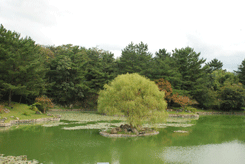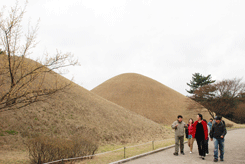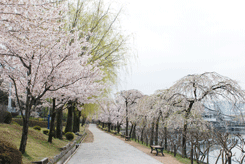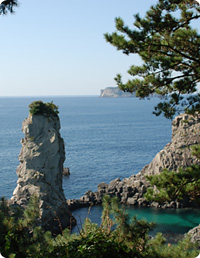WALKING
Gyeongju / 4 hours



Tour Highlights
- Gyeongju National Museum
- Anapji Pond
- Banwolseong Fortress
- Seokbingo Freezer
- Cheomseongdae Astronomical Observatory
- Tumuli Park
- Seongdong Market
Gyeongju (- - -)
The Gyeongju Historic Areas contain a remarkable concentration of outstanding examples of Korean Buddhist art, in the form of sculptures, reliefs, pagodas, and the remains of temples and palaces from the flowering, in particular between the 7th and 10th centuries, of this form of unique artistic expression.
Visit Gyeongju National Museum for a great insight into Silla culture and history. The first thing that you will notice is The Bell of King Seongdeok, the largest extant bell in Korea. You must certainly stand in awe before the bell from the 8th century with such artistic beauty of design. The bell is distinguished not only for its outstanding beauty but also for its long reverberating sound, the incredibly precise casting technique, in addition to the sad legend surrounding it. On entering the museum, you will marvel at the priceless archaeological and historical artifacts including splendid gold crowns, earrings, belts, ornaments, glassware, potteries, and clay figures as well as a royal barge.
Next, explore Anapji, a pleasure garden built to commemorate the victory of Silla, and later used as the recreational area for the Silla's royal family, followed by a relaxed walking tour covering the ruins of Banwolseong or half moon fortress where Silla palace and eight fortress gates stood. There is a Seokbinggo, a freezer made of stones. Half of the structure is underground while the other half is above ground with three air vents on top. You can feel the cold oozing out of this simple structure. Near fortress is Gyerim, literally meaning Rooster Forest. It is a sacred woodland area where progenitor of the Gyeongju Kim family, Kim Alji, was supposed to have been born.
Check out Cheomseongdae, known as the world's oldest existing astronomical observatory. Each stone used in the observatory bears symbolic meaning; the same number of the days of the year by lunar calendar, the number of the major stars, the months of the year and the numbers of the seasonal divisions. Nearby Tumuli Park encompasses 23 huge tomb mounds where Silla rulers were buried. One of the tombs, Cheonmachong, is opened to the public and you can go inside and see how the tombs were made and replicas of the treasures excavated in 1973.
After strolling through the busiest district of the city, you also explore Seongdong market, where you will see a classic example of the Korean market with lots of fresh vegetables, seafood, food stands and some textiles. The market spills out on to the street and local vendors, many elderly women sell home-grown vegetables and grains.






